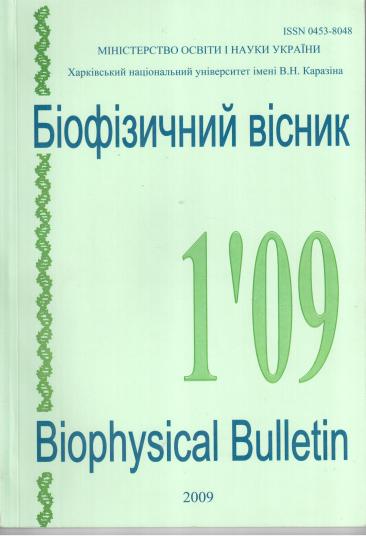Hydration of DNA - polyamine complexes
Abstract
The dielectric properties of water solutions of spermine, putrescine, and complexes of DNA - spermine, DNA - putrescine were studied in the range of millimeter wavelengths. The extent of hydration and probable hydration-active centers were determined for both ligands. It was shown that the influence of complexation on the dielectric properties of solutions is due to variations in the hydration shell of DNA. It was found that gamma irradiation induces the notable changes of both the dielectric parameters and hydration values for the DNA-spermine complex. The hydration effects have been analyzed using the modern models for interaction between DNA and polyamines and the models of the protective action of polyamines.
Downloads
References
Pegg A.E. // Cancer Res. 1988. V.48. P.759-774.
2.
Deng H., Bloomfield V.A., Benevides J.M. et al. // Nucleic Acids Res. 2000. V.28. P.3379-3385.
3.
Raspaud E., Durand D., Livolant F. // Bioph. J. 2005. V.88. P.392-403.
4.
Liquori A.M., Constantino L., Crescenzi V. et al. // J. Mol. Biol. 1967. V.24. P.113-122.
5.
Teif V. B. // Bioph. J. 2005. V.89. P.2574-2587.
6.
Vijayanathan V., Thomas T., Antony T. // Nucleic Acids Res. 2004. V.32. P.127-134.
7.
Rider J. E., Hacker A., Mackintosh C. A. et al. //Amino Acids. 2007. V.33. P.231-240.
8.
Qu X., Chaires J. B. // J. Am. Chem. Soc. 2001. V.123. P.1–7.
9.
Кашпур В.А., Малеев В.Я., Щеголева Т.Ю. // Молекулярная биология. 1976. Т.10. С.568-575.
10.
Кашпур В.А., Дубовицкая О.В., Красницкая А.А., Малеев В.Я. // Радиофизика и электроника. 1997. Т.2. С.153-155.
11.
Хорунжая О.В., Кашпур В.А., Красницкая А.А., Малеев В.Я.. // Біофіз. вісник. 2005. Вип.1(15). С.68-72.
12.
Ellison W.J., Lamkaouchi K., Moreau J.-M. // J. Molec. Liquids. 1996. V.68. P.171-279.
13.
Ахадов Я.Ю. Диэлектрические свойства бинарных растворов. М.: Наука. 1977. 400 с.
14.
Buchanan T.J., Haggis G.M., Hasted J.B et al. // Proc. Roy. Soc. 1952. V.A213. P.379-391.
15.
Wei Y., Sridhar S. // IEEE. MTT-S Digest. 1992. P.1271-1274.
16.
Mashimo S., Kuwabara S., Yagihara S., et al. // J. Phys. Chem. 1987. V.91. P.6337-6338.
17.
Бреслер С.Е. Введение в молекулярную биологию. М.: Наука. 1970. 580 с.
18.
Зенгер В. Принципы структурной организации нуклеиновых кислот. 1987. М.: Мир. 584 с.
19.
Maleev V.Ya., Kashpur V.A., Glibitsky G. M. et al. // Biopolymers. 1987. V.26. P.1965-1970.
20.
Feuerstein B.G., Pattabiraman N, Marton L.J. // Proc. Natl. Acad. Sci. USA. 1986. V.83. P.5948-5952.
21.
Drew H.R., Dickerson R.E. // J. Mol. Biol. 1981. V.151. P.535-556.
22.
Korolev N., Lyubartsev A.P., Laaksonen A. // Bioph. J. 2002.
V.82. P.2860-2875.
23.
Ruiz-Chica J., Medina M.A., Sanchez F. // Bioph. J. 2001. V.80. P.449-454.
24.
Quameur A.A., Tajmir-Riahi H.-A. // J.Biol.Chem. 2004. V.279. P.42041-42054.
25.
Korolev N., Lyubartsev A.P., Laaksonen A. // Nucleic Acids Res. 2003. V.31. P.5971-5981.
26.
Williams L.D., Frederick C.A., Ughetto G. et al. // Nucleic Acids Res. 1990. V.18. P.5533-5541.
27.
Хорунжая О.В., Семенов М.А., Кашпур В.А. // Біофіз. вісник. 2001. Вип.1(8). С.37-41.
28.
Spotheim-Maurizot M, Ruiz S, Sabattier R, et al. // Int. J. Radiat. Biol. 1995 V.68. P.571-577.
29.
Ha H.C., Sirisoma N.S., Kuppusamy P. // Proc. Natl. Acad. Sci. USA. 1998. V.95. P.11140–11145.
30.
Das K. C., Misra H.P. // Molec. and Cell. Biochemistry. 2004. V.262. P.127-133.
31.
Douki T., Bretonniere Y., Cadet J. // Radiat Res. 2000. V.153. P.29-35.
32.
Newton G.L, Aguilera J.A., Ward J.F. et al. // Radiat Res. 1996. V.145. P.776-80.
33.
Gerner E.W., Tome M.E., Fry S.E. et al. // Cancer Research 1988. V.48. P.4881-4885.
34.
Saminathan M.T. Thomas T., Shirahata A. // Nucleic. Acids Res. 2002. V.30. P.3722-3731.
35.
Manning G.S. // Q. Rev. Biophys. 1978. V.11. P.179-246.
36.
Raspaud E.M., Olvera de la Cruz M., Sikorav J.-L. // Bioph. J. 1998. V.74. P.381-393.
37.
Burton D.R., Forsen S., Reimarsson P. // Nucleic Acids Res. 1981. V.9. P.1219-1228.
Authors who publish with this journal agree to the following terms:
- Authors retain copyright and grant the journal right of first publication with the work simultaneously licensed under a Creative Commons Attribution License that allows others to share the work with an acknowledgement of the work's authorship and initial publication in this journal.
- Authors are able to enter into separate, additional contractual arrangements for the non-exclusive distribution of the journal's published version of the work (e.g., post it to an institutional repository or publish it in a book), with an acknowledgement of its initial publication in this journal.
- Authors are permitted and encouraged to post their work online (e.g., in institutional repositories or on their website) prior to and during the submission process, as it can lead to productive exchanges, as well as earlier and greater citation of published work (See The Effect of Open Access).





